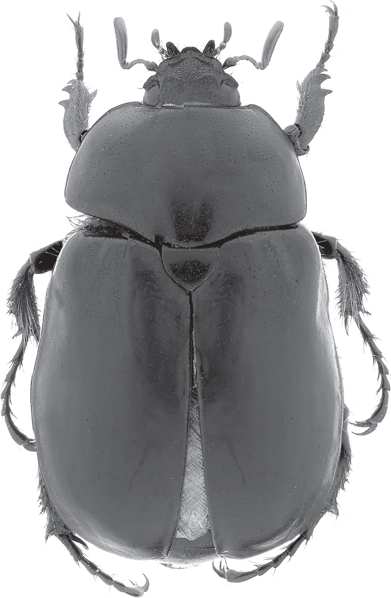RuteliscaBates, 1888, is a little-known genus of scarab beetles that includes two black moderate-sized species (10-15 mm) of Mexico (Morón, 1994; Jameson, 2000). Rutelisca was considered by Bates (1888) as an intermediate genus between the tribes Rutelini and Cyclocephalini. The phylogenetic relationships of Rutelisca with other members of Rutelini are unstable, but the last classification includes to Rutelisca and MethapachylusBates, 1888, in the "Rutelisca lineage" (Jameson, 1998, 2000). Rutelisca shows a very interesting biogeographic affinity: is a relict taxa related to the Old World genus Desmonyx Arrow, 1907, to Parastasia Westwood, 1841, to the Chilean Oryctomorphus Guerín-Méneville, 1830 and to the Mesoamerican Methapachylus (Morón, 1994; Jameson, 2000).
Members of Rutelisca can be recognized by mandibles with one recurved apical tooth, mentum with apex reflexed into oral cavity, frontoclypeal suture incomplete medially and cariniform laterally, apex of metatibia with spinules, apex of profemur dilated and rounded, protibial base with notch, meso- and metatarsal claws widely cleft in male and female (Jameson, 2000). Rutelisca flohriBates, 1888, is distinguished by its elytral striae (lacking in R. durangoana Ohaus, 1905); terminal segment of the maxillary palp with a dorsal-longitudinal flattened area that extends from the base to the apical third or fourth (extends from the base to the middle of the segment in R. durangoana); males with dorsal maculae on frons, lateral margins of pronotum, bases and apices of elytra (males of R. durangoana with maculae only on frons); female with dorsal macula on the frons (macula lacking in R. durangoana) and clypeal apex narrowly parabolic (apex broadly parabolic in R. durangoana), basis of parameres in R. flohri are broadly projected outwards, while in R. durangoana those are narrow (Jameson, 2000).
The formerly known distribution of R. flohri encompassed mountain pine-oak forests from Colima, Estado de México, Distrito Federal, Guerrero, Jalisco, Oaxaca and Veracruz, at elevations of 1800-2600 masl (Morón, 1994, 1997; Jameson, 2000; Rivera-Cervantes & García-Real, 2008; Ramírez-Ponce et al., 2009). Herein, I provide a new state record for Rutelisca (Figure 1): one female identified as R. flohri, labeled "México, Acajete, Pue. Acajete. 3/VII/2013, C. D. luz pública, y- 97°57'13.16" W, x- 19°6'23.2" N, zona urbana, 2460 m, P. Moctezuma J. Victor Col.". The specimen was captured manually at urban light, and has a total length of 18 mm from the clypeus border to the pygidium and a maximum elytral width of 11 mm. The voucher specimen was deposited in the author personal collection (Victor Moctezuma Collection, Puebla, Mexico). With this new record, the scarab beetles from Puebla include at least 316 species and 85 genera (Aragón et al., 2011; Morón et al., 2013).
The examined specimen was found in a small urban zone (Acajete, Puebla) beside a pine-oak forest nucleus (Figure 2). The currently known distribution of R. flohri extends on the Trans-Mexican Volcanic Belt and the Sierra Madre del Sur (Morón, 1994, 1997; Jameson, 2000, Rivera-Cervantes & García-Real, 2008; Ramírez-Ponce et al., 2009). Rutelisca flohri could inhabit the wide pine-oak forest areas of Tlaxcala, Morelos, and Michoacán.











 nova página do texto(beta)
nova página do texto(beta)




